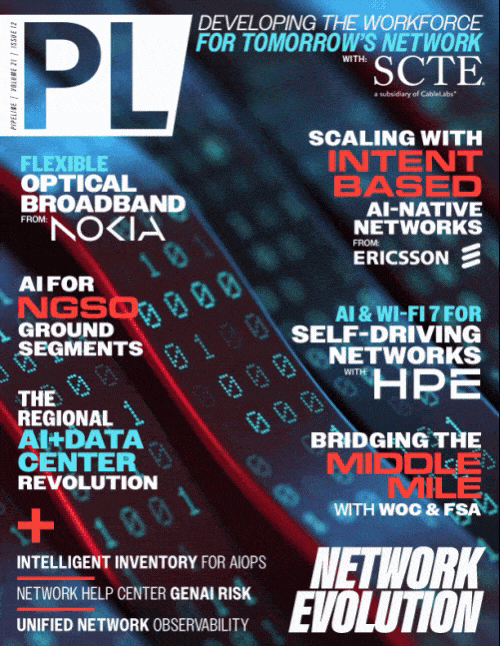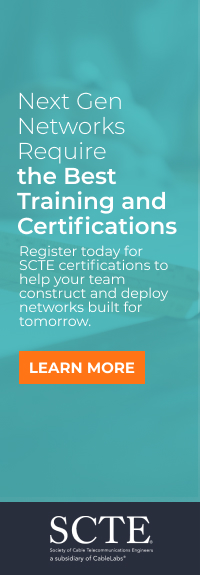Rethinking Workforce Development
for Tomorrow's Workforce
For example, new programs are now allowing professionals to earn academic credit for completing industry-recognized courses, significantly reducing the time and cost required to obtain a college certificate or degree and providing real-world experience for the skills needed today. As just one example, SCTE launched its third partnership with a university partner, Colorado State University Global, to deliver CSU Global’s fully online Broadband Operations Management Certificate, which integrates hands-on, work-based learning with flexible, asynchronous coursework. This partnership joins similar relationships with Ft. Hays State and Rio Salado College, accepting SCTE industry certifications for college credit.
The recent online initiative with CSU Global accomplishes several critical goals simultaneously. First, it creates an accessible on-ramp into the industry for new entrants, career-changers, and individuals in underserved communities. The online format removes geographical barriers, allowing a student in a rural area to access the same high-quality training as someone in a major metropolitan hub. Second, it provides a clear upskilling pathway for incumbent workers, enabling them to acquire the leadership and management skills needed to advance in their careers. By bringing together practical industry training with academic rigor, these alliances legitimize broadband careers and create a powerful engine for talent attraction and retention. Ultimately, we cannot close the nation’s digital divide without first closing this critical skills divide.
Leveraging Technology to Accelerate Skill Acquisition
Just as technology is revolutionizing our networks, it is also poised to revolutionize how we train our workforce. The next generation of learning tools will be more immersive, intelligent, and personalized than ever before, dramatically accelerating the journey from novice to proficient practitioner.
The global artificial intelligence (AI) in education market, for instance, is projected to reach $32.27 billion by 2030, growing at a CAGR of 31.2% from 2025 to 2030. AI is moving from the back office to the front lines as a powerful performance support tool. Imagine a technician in the field equipped with an AI-powered virtual mentor on their tablet or smartphone. Trained in industry standards, equipment specifications, and vast datasets of network performance, this AI assistant can provide real-time guidance, suggest next steps for complex troubleshooting, and surface relevant technical documentation precisely when needed. This “augmented intelligence” doesn’t replace human expertise; it enhances it, enabling technicians to solve problems faster, more safely, and with greater accuracy.
Furthermore, technology can transform how we validate competency. Instead of relying solely on traditional multiple-choice exams, we can move toward performance-based assessments. By using AI to monitor real-time work and network telemetry, we can capture how technicians actually perform on the job—measuring their ability to apply skills, resolve issues, and maintain network performance under real conditions. These tools can objectively certify individuals against established standards, turning everyday job performance into verifiable proof of competency. This approach provides immediate, targeted feedback to the learner and offers employers a much richer, more accurate picture of their workforce’s true capabilities.
A Call for Collective Investment
The future of broadband connectivity is being built today, and the quality of that future will be determined by the quality of the people we empower to build it. The challenges are clear: an aging workforce, the escalating complexity of our networks, and a persistent shortage of qualified talent. Yet, the opportunities are even greater.
Meeting this moment requires a paradigm shift. We must view workforce development not as a cost center, but as a strategic investment as fundamental as fiber optic cable or spectrum allocation. It demands a unified commitment from every corner of our industry. Operators must invest in continuous training and create cultures that champion learning. Technology partners must continue to innovate learning tools that make skill acquisition more effective and efficient. Educators must collaborate with industry to create relevant and accessible academic programs. And policymakers must recognize that funding infrastructure without funding the people to build and maintain it is a job left half-done.
The task ahead is to build a robust, diverse, and sustainable talent pipeline capable of powering the broadband industry for the next decade and beyond. By embracing new models of learning, forging strategic alliances, and collectively investing in our people, we can ensure that the promise of a fully connected future becomes a reality for all.


















